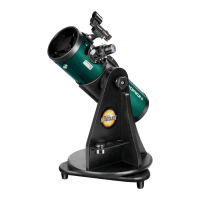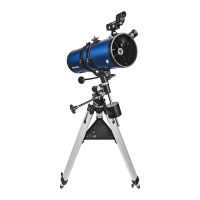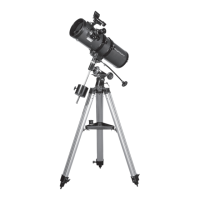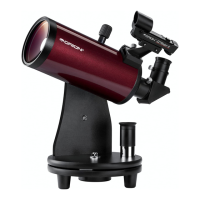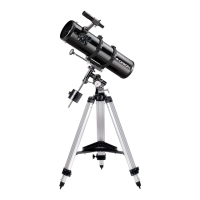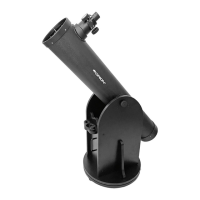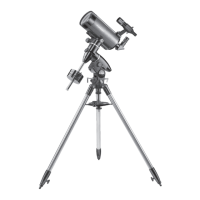8
your telescope to acclimate to the temperature outdoors before
you start observing with it.
Let Your Eyes Dark-Adapt
Don’t expect to go from a lighted house into the darkness of the
outdoors at night and immediately see faint nebulas, galaxies,
and star clusters—or even very many stars, for that matter. Your
eyes take about 30 minutes to reach perhaps 80% of their full
dark-adapted sensitivity. As your eyes become dark-adapted,
more stars will glimmer into view and you’ll be able to see fainter
details in objects you view in your telescope.
To see what you’re doing in the darkness, use a red-ltered ash-
light rather than a white light. Red light does not spoil your eyes’
dark adaptation like white light does. A ashlight with a red LED
light is ideal. Beware, too, that nearby porch lights, street lights,
and car headlights will ruin your night vision.
“Seeing" and Transparency
Atmospheric conditions vary signicantly from night to night.
“Seeing" refers to the steadiness of the Earth’s atmosphere at a
given time. In conditions of poor seeing, atmospheric turbulence
causes objects viewed through the telescope to “boil." If you look
up at the sky and stars are twinkling noticeably, the seeing is
poor and you will be limited to viewing at lower magnications. At
higher magnications, images will not focus clearly. Fine details
on the planets and Moon will likely not be visible.
In conditions of good seeing, star twinkling is minimal and
images appear steady in the eyepiece. Seeing is best overhead,
worst at the horizon. Also, seeing generally gets better after mid-
night, when much of the heat absorbed by the Earth during the
day has radiated off into space.
Especially important for observing faint objects is good “trans-
parency" – air free of moisture, smoke, and dust. All tend to scat-
ter light, which reduces an object’s brightness. Transparency is
judged by the magnitude of the faintest stars you can see with
the unaided eye (6th magnitude or fainter is desirable). If you
cannot see stars of magnitude 3.5 or dimmer then conditions
are poor. Magnitude is a measure of how bright a star is – the
brighter a star is, the lower its magnitude will be. A good star to
remember for this is Megrez (mag. 3.4), which is the star in the
“Big Dipper" connecting the handle to the “dipper". If you cannot
see Megrez, then you have fog, haze, clouds, smog, or other
conditions that are hindering your viewing. (See Figure 11.)
Tracking Celestial Objects
The Earth is constantly rotating about its polar axis, complet-
ing one full rotation every 24 hours; this is what denes a “day".
We do not feel the Earth rotating, but we see it at night from
the apparent movement of stars from east to west. When you
observe any astronomical object, you are watching a moving
target. This means the telescope’s position must be continu-
ously adjusted over time to keep a celestial object in the eld
of view. This is called “tracking" the object. It’s easy to do with
the StarBlast 6 because of its smooth motions on both axes.
As the object moves off toward the edge of the eyepiece’s eld
of view, just lightly nudge or tug the telescope to re-center the
object. Objects appear to move across the eld of view faster at
higher magnications. This is because the eld of view becomes
narrower.
What to Expect
So what will you see with your telescope? You should be able to
see bands on Jupiter, the rings of Saturn, craters on the Moon,
the waxing and waning of Venus, and many bright deep-sky
objects. Do not expect to see color as you do in Hubble Space
Telescope photos, since those are taken with long-exposure
cameras and have “false color" added. Our eyes are not sensi-
tive enough to see color in deep-sky objects. But remember that
you are seeing these objects using your own telescope with your
own eyes, in real time. And that’s pretty cool!
V. Objects to Observe
Now that you are all set up and ready to go, one critical decision
must be made: what to look at?
A. The Moon
With its rocky surface, the Moon is one of the easiest and most
interesting targets to view with your telescope. Lunar craters,
maria, and even mountain ranges can all be clearly seen from
a distance of 238,000 miles away! With its ever-changing phas-
es, you’ll get a new view of the Moon every night. The best time
to observe our one and only natural satellite is during a partial
phase, that is, when the Moon is NOT full. During partial phases,
shadows are cast on the surface, which reveal more detail, espe-
cially right along the border between the dark and light portions
of the disk (called the “terminator"). A full Moon is too bright and
devoid of surface shadows to yield a pleasing view. Make sure
to observe the Moon when it is well above the horizon to get the
sharpest images. Use the included Moon Filter to dim the Moon
when it is very bright. It simply threads onto the bottom of the
eyepiece barrel. You’ll nd that a Moon lter improves viewing
comfort, and also helps to bring out subtle features on the lunar
surface.
B. The Sun
You can change your nighttime telescope into a daytime Sun
viewer by installing an optional full-aperture solar lter over the
front opening of the telescope. The primary attraction is sunspots,
which change shape, appearance, and location daily. Sunspots
are directly related to magnetic activity in the Sun. Many observ-
ers like to make drawings of sunspots to monitor how the Sun is
changing from day to day.
Figure 11. Megrez connects the Big Dipper’s “handle” to its
“pan.” If you cannot see Megrez, a magnitude 3.4 star, then the
viewing conditions are poor.
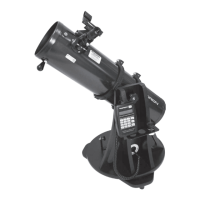
